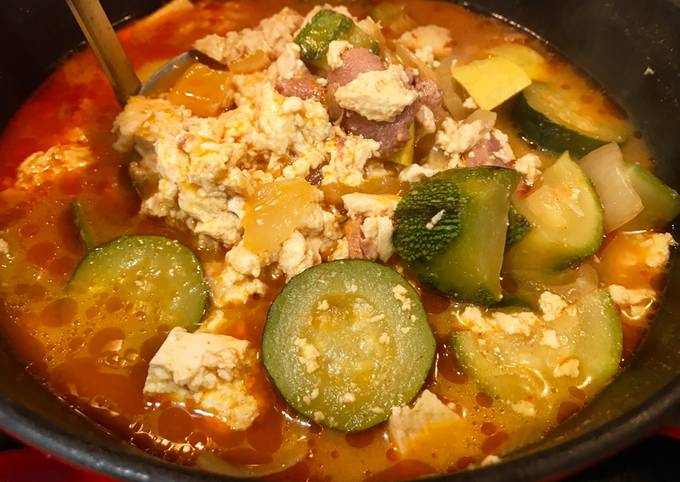Spicy Hobak Jjigae (Korean Squash Stew) with Pork & Tofu. Give the jjigae a few good stirs. You'll see the jjigae change color as the dwenjang and gochujang dissolve into the broth. If using pork (or beef), preheat the pot with a little bit of oil.
 Gochujang Hobak Jjigae (Spicy Zucchini Stew) My light and meatless take on a classic Korean stew that traditionally uses beef or pork.
The broth is made with dried anchovy stock so it's not vegetarian.
Usually when I cook with pork I add kimchi, but this one doesn't have any kimchi at all.
You can cook Spicy Hobak Jjigae (Korean Squash Stew) with Pork & Tofu using 9 ingredients and 5 steps. Here is how you cook that.
Gochujang Hobak Jjigae (Spicy Zucchini Stew) My light and meatless take on a classic Korean stew that traditionally uses beef or pork.
The broth is made with dried anchovy stock so it's not vegetarian.
Usually when I cook with pork I add kimchi, but this one doesn't have any kimchi at all.
You can cook Spicy Hobak Jjigae (Korean Squash Stew) with Pork & Tofu using 9 ingredients and 5 steps. Here is how you cook that.
Ingredients of Spicy Hobak Jjigae (Korean Squash Stew) with Pork & Tofu
- It's 1/2 of onion, diced.
- It's 1-2 of jalapeños, cut into 1/8" thick slices.
- Prepare 2-4 of garlic cloves peeled and smashed (or chopped).
- Prepare 1/2 pound of pork shoulder, thinly sliced.
- It's 1/4 cup of dwenjang (Korean soybean paste) OR miso (which is the Japanese version).
- Prepare 1/4 cup of gochujang (Korean chili paste).
- You need 4 cups of water.
- You need 4 cups of calabacita squash or zucchini, cut into 1/2" thick slices (about 2 to 3 medium squashes).
- You need 1 (14 oz.) of package tofu (can be any firmness).
And even though it's made with pork belly, it's not greasy at all. Doejigogi Hobak jjigae, 돼지고기 호박찌개 (Spicy Pork and Zucchini Stew) Very simple and easy to make stew with pork and zucchini. When you have abundant zucchini, this will make a great meal with some rice. Hope you enjoy all these great Korean stews that I simmered with love in my kitchen.
Spicy Hobak Jjigae (Korean Squash Stew) with Pork & Tofu instructions
- Put all ingredients except squash and tofu in a pot, cover, turn the heat to medium high, and cook for 15 minutes..
- Give the jjigae a few good stirs. You'll see the jjigae change color as the dwenjang and gochujang dissolve into the broth. Let the jjigae continue cooking uncovered for 2 to 3 minutes until it comes to a boil..
- Add squash, give it a few good stirs, and cook another 15 minutes covered..
- Crumble tofu into the jjigae. (This is not typical - usually it's cut into cubes or slices - but I like it this way because the tofu picks up more flavor from the broth.) Cover and cook another 10 minutes. Don't worry that the broth is constantly boiling rather than simmering. Jjigae gets its well developed pungency from this constant application of higher heat and the resulting compounding, melding, and reduction of flavors..
- At this point, give everything another good stir and see if you need to adjust the seasoning. If it tastes fine, you're done. If a little too salty, add a touch of water. If you want more saltiness, you can add a little more dwenjang and/or gochujang, remembering that the gochujang is much hotter (as in spicy) than the dwenjang. If you do adjust the seasoning, let it boil another 4 or 5 minutes to let the new level of seasoning meld. That's it. Enjoy!.
Add remaining oil, onion, garlic, gochujang, gochugaru, and soy sauce, mixing to combine. Pour the water into the pot and bring to a boil. This Korean stew usually combines kelp and anchovy stock with kimchi, baked beans, spam, and hot dog sausages, while the common addition also includes ramen noodles, pork, potato noodles, rice cakes, or tofu. After the pork is all sliced, cover it and stash it in the fridge. Once the kimchi is tender, gently deposit the sliced pork in the pot and stir it well to make sure the meat is covered in the stewing liquid.